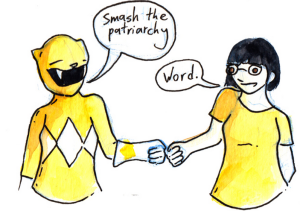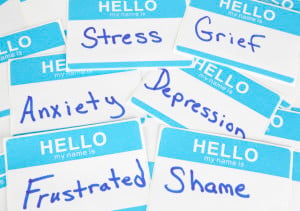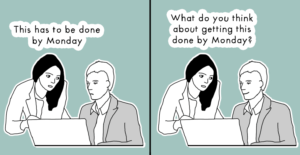
A young person appearing worried stands against a lime green wall.
Over 52 million Americans – or 21.3% of the population – participate in government assistance programs every month in the United States.
These programs are often referred to collectively as “the social safety net.”
Sixty-five percent of America’s children live in households relying on that safety net. A majority of Americans – up to 70% – rely on some combination of the programs within it at some point in their lives, and it’s even arguable that each and every single one of us have received government assistance.
The social safety net is a part of the fabric of our nation – and an integral thread at that. Yet government assistance programs are constantly under attack.
Politicians often rail against these programs, painting the people who participate in them as lazy “takers” who abuse assistance programs in order to escape their responsibilities. Others ruthlessly attempt to cut the programs in order to lower taxes or do all they can to make these programs less accessible to the people who need them.
The myths about the social safety net that run rampant in our culture are part of the class war. They’re being put out there in order to manipulate us into fighting against one another instead of railing against a system that economically disadvantages a large majority of us.
But the truth is, the social safety net is keeping everyone afloat.
It’s not always easy to see how the social safety net shapes your life, especially if you’re not using it to make ends meet or relying on it to survive. But once you take a deeper look, it’s easy to connect the dots.
Whether you’ve internalized some of the myths about the social safety net yourself or need to shine a light on the topic for someone else, making these connections between the social safety net as a series of policies and programs and the way it’s inextricably shaped your own experience will change how you think about government assistance, the people who rely on it, and the fight to preserve it.
Here are five ways cutting the social safety net would have a tangible – and negative – impact on all of us.
1. 40 million people would be in poverty – and our economy would suffer.
In 2011, federal benefits programs kept 40 million people out of poverty. In 2012, that number was 48 million. In 2013, it was 39 million. And a major study found that over the last fifty years, the poverty rate has decreased by one-third thanks to government programs – and that without them, it would have instead increased.
Year after year, government assistance and tax credits keep an incredible number of families out of poverty.
Let’s go back to 2013. That year, the Census found that 48 million people lived in poverty. Their analysis also found that without social security, an additional 27 million would have fallen below the poverty line; without tax credits, 8.8 million people in working families would have been working poor; and without SNAP, 4.8 million people would have succumbed to poverty.
None of this should come as a surprise. The government invented what we know as the middle class after the Great Depression by launching assistance programs and putting place tax credits that alleviated working families of some of their tax burden. Because as much as politicians beg to disagree, the social safety net is good for our economy.
In fact, programs like welfare and SNAP actually stimulate the economy by creating room for socioeconomic mobility and decreasing the economic losses of actual poverty. For every dollar spent on unemployment insurance, for example, two dollars are funneled back into the economy.
It isn’t just the poor who benefit from the social safety net. It’s all of us who have a stake in this economy.
Poverty costs our economy more than $500 billion every year. The combined impact of poverty – on health, crime, and productivity – has far more devastating impacts than the costs of preventing and alleviating poverty through government programs.
Social safety net programs put a “ripple effect” into play in our economy. These programs boost economic mobility and make it possible for the poor and working poor to regain their footing and become more active participants in the economy – both as employees and consumers.
Whereas poverty might doom an economy to remain stagnant or even decline, government assistance helps keep the wheels of the economy turning.
A poor family is able to buy more groceries because of government assistance, which in turn allows their local grocer to keep more employees on retainer, which in turn prevents further poverty and keeps more and more Americans out of poverty.
Rather than fueling a cycle of poverty that costs the government billions, the social safety net fuels a cycle of mobility that empowers individuals and families to reach a point of economic stability.
2. 45 million Americans would go hungry – and face the health consequences of food insecurity.
45 million Americans currently rely on SNAP. (Half of them are children.) That’s one in seven Americans – the same fraction of people in this country who are also relying on food banks to make do in tight economic times.
SNAP levels remain consistent with the levels of relative poverty in the country – meaning that as poverty increases, so does reliance on SNAP.
And that’s no surprise: SNAP is often what makes the difference for poor families between having food on the table and, well, not.
SNAP reduces food insecurity among high-risk kids by 20 percent. It reduces household food insecurity – and extreme food insecurity – by five to 10 percent. Without SNAP, millions of households would make a choice, every day, between buying food or paying for other basic necessities.
Without programs like SNAP, millions of Americans would go hungry.
Hunger in America isn’t about a lack of food. We’ve got food in abundance – and a whole lot of it ends up wasted.
Food insecurity and hunger here are exclusively issues of poverty: People can’t afford to eat, or can’t afford to eat right. What that means is that SNAP is not only a lifeline for would-be hungry poor folks, but it’s also increasing their quality of life long-term.
Food insecurity has long-lasting consequences beyond hunger.
Children who grow up in households struggling to put food on the table are at higher risk for stunted growth and heart disease. They’re less likely to graduate from high school. SNAP doesn’t just help feed these kids: It helps fuel their future, and it helps shape a future in which they’re healthy adults.
Poverty makes it harder for Americans to buy the “right” foods. Buying fresh produce – or even frozen produce – can be out of reach for the working poor.
And without SNAP, those families would be stuck buying whatever they can afford – which too often means fast food and junk food. Data shows that SNAP, however, helps families expand their food budget and make room in it for fruit and vegetables.
SNAP is making it possible for even the poorest Americans to nourish themselves the way we all must to truly survive and thrive. Without SNAP, and programs like it, millions of Americans would needlessly suffer the health and educational consequences of food insecurity in one of the richest nations in the world.
3. Losing a job would mean losing everything.
In 2010, unemployment insurance kept 3.2 million Americans out of poverty. This kind of government assistance is critical, especially in an uncertain or recovering economy like ours.
When people lose their jobs, they shouldn’t lose everything else.
Unemployment insurance makes sure they have solid ground to stand on while they look for employment.
And yet, in 2012, right as the Great Recession was coming to a close, unemployment insurance was on the chopping block in Congress. That put millions of Americans currently relying on it and millions more who eventually would in real danger.
We’ve already discussed the economic benefits of government programs like unemployment insurance, as well as the vital importance of keeping folks out of poverty – not only for moral reasons, but for sheer economic ones.
Ensuring that folks who find themselves jobless don’t immediately end up out on the street or struggling to feed their families is part of the necessary work of keeping the economy afloat – and making sure all Americans have a fair shot, even in hard times.
4. A majority of college students wouldn’t actually be able to pay for college, removing a pathway to the middle class.
In 2013, for the first time ever, a majority of undergraduate students were receiving federally-funded financial aid to cover the costs of their college tuition.
Fifty-seven percent of students that year were relying on federal loans and Pell Grants to pay for their education – right at a time when college costs are skyrocketing, putting many lower-income students at a huge disadvantage in a country where having a degree is now required in a majority of entry-level jobs.
College is a major pathway to economic mobility – and without federal assistance, the most underprivileged Americans wouldn’t have a viable way to complete their higher education.
In 2011, Pell Grant spending was $35.6 billion – an all-time high. 41 percent of all undergraduates were receiving them that year. Pell Grants go to students who only meet a specific threshold – essentially, proving that they are among the poorest of Americans applying for financial aid through the government that year.
I received a Pell Grant. It was the only reason I qualified for the additional support I received to cover my tuition. Without both sources of financial aid, I wouldn’t have been able to go to college.
And without the Pell Grant, I would’ve been up a creek without a paddle. I may not have been able to complete my education – which was my only sure way out of the working-class and into the middle-class.
Without federal aid, young people who come from lower-income homes wouldn’t have the opportunity to lift themselves out of poverty through a college education.
As tuition rises at colleges across the country, financial assistance from the government to cover tuition has become only more essential to the would-be students who come from lower-income families. If we cut off that support, the people left at the biggest disadvantage would be the poorest students.
5. Millions of Americans wouldn’t have access to the healthcare they need.
Between Medicaid, the Children’s Health Insurance Program (CHIP), and the Affordable Care Act (ACA), the social safety net has helped millions of Americans receive the healthcare they need – and saved countless lives in the process.
Ninety percent of Americans now have health insurance under the ACA. An estimated 16.4 million Americans have gained coverage under the law. Many Americans are receiving financial assistance for their plans, and under the ACA more care is automatically covered – including wellness care for women – and less loopholes exist to disadvantage the chronically ill, for example, from accessing the care they need and deserve.
For millions of Americans, the ACA has literally been a lifesaver.
But the ACA follows a long line of publicly-funding care and assistance for care that are part of the Social Safety Net. Programs like CHIP and Medicaid had been picking up some of the pieces of our broken health care system for years before the ACA was in place – and in the process, helped some of the most financially vulnerable Americans access the care they needed.
In 2012, 8 million children relied on CHIP. In 2013, 28 million children were enrolled in Medicaid. Studies have shown that Medicaid and CHIP combined do more to help low-income children than private insurance, and rural children rely on them more now than ever.
Millions of low-income kids rely on government assistance to stay healthy. Without it, they may not have access to the kind of care that sets them up for a health adult life.
Both Medicaid and CHIP specifically allow kids who would otherwise lack the resources to access basic care like vaccinations, dental visits, eye exams, and prescription drugs. If children didn’t have access to this care, the consequences long-term would obviously be damaging – both to them and to public health.
These days, millions of Americans have a shot at living a long and healthy life who didn’t a few years ago. The social safety net is a large reason that’s possible.
***
This is just the tip of this particular iceberg. The social safety net is so intertwined with our country’s economy that cutting it – or getting rid of it entirely – would devastate us in myriad ways.
Whether or not you’re on welfare or receiving tax credits, the impact of scaling back the social safety net will impact your life – and have overwhelming consequences for our country.
Preserving government assistance programs isn’t just an economic imperative. It’s a moral imperative – and one feminists must take up the mantle and champion.
If we want to defeat classism and truly create mobility and opportunity for all, we need to fight for the social safety net. If we want to end poverty, we need to fight for the social safety net.
It’s women who are often making ends meet with government assistance. In fact, many of the programs we’ve discussed in this piece are specifically offered to women – and to mothers. A disproportionate amount of the people living in poverty are women and their children, and feminism needs to make sure we don’t leave them behind.
To do so would be an awful failure on our part to fight for every woman – and especially those who need the movement’s support most of all.
[do_widget id=’text-101′]
Carmen Rios is a Contributing Writer for Everyday Feminism. She splits her time disparately between feminist rabble-rousing, writing, public speaking, and flower-picking. A professional feminist by day and overemotional writer by night, Carmen is currently Communications Coordinator at the Feminist Majority Foundation and the Feminism and Community Editor at Autostraddle. You can follow her on Twitter @carmenriosss and Tumblr to learn more about her feelings.
Search our 3000+ articles!
Read our articles about:
Our online racial justice training
Used by hundreds of universities, non-profits, and businesses.
Click to learn more




















